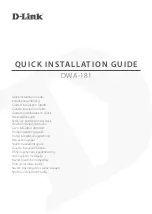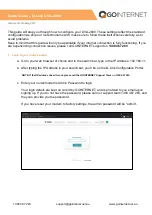
62
➊
●
Protocol
— A standard that enables connection, communication, and data transfer between
computing endpoints.
➊
●
Proxy
— A firewall mechanism that replaces the IP address of a host on the internal (protected)
network with its own IP address for all traffic passing through it.
➊
●
RAS
— Remote Access Service. A Windows NT/2000 Server feature that allows remote users access to
the network from their Windows laptops or desktops via modem.
➊
●
Rev A
— CDMA EV-DO Rev. A is a leading-edge wireless technology with higher data rates and higher
system capacity. It is a fully backward compatible standard and remains interoperable with deployed
EV-DO networks and devices around the world. The increased data rates on Rev. A’s physical layer
enable richer applications and services. For more information, visit
www.cdg.org
.
➊
●
RFB
— Remote Frame Buffer. A protocol for remote access to graphical user interfaces.
➊
●
Router
— A device that directs traffic from one network to another.
➊
●
RTP
— Real-time Transport Protocol. A packet format for streaming multimedia over the Internet.
➊
●
SMTP
— Simple Mail Transfer Protocol. An Internet standard for email transmission across IP networks.
➊
●
SSID
— Service Set IDentifier. The name assigned to a WiFi network.
➊
●
TCP
— Transmission Control Protocol. A core protocol for transmitting and receiving information over
the Internet.
➊
●
TCP/IP
— Transmission Control Protocol/Internet Protocol. The set of communications protocols used
for the Internet and other similar networks.
➊
●
Telnet
— Telecommunication Network. A network protocol used on the Internet or on local area
networks.
➊
●
TFTP
— Trivial File Transfer Protocol. A file transfer protocol with a subset of FTP functionality.
➊
●
UA
— User Agent. Any device or software used to access a web page. A user agent might be a web
browser, a smart phone, or a screen reader.
➊
●
UDP
— User Datagram Protocol. A simple transport protocol used to transfer information on the
Internet.
➊
●
UI
— User Interface. The part of a software application or hardware device that a user sees and
interacts with.
➊
●
USB
— Universal Serial Bus. A connection type for computing device peripherals such as a printer or
mobile modem. USB connectors may be used for data transfer or charging.
➊
●
USB Port Types
— The USB ports on computers and hubs have a rectangular Type A socket, and
peripheral devices have a cable with a Type A plug. Peripherals that do not have an attached cable
have a square Type B socket on the device and a separate cable with a Type A and Type B plug. Ports
and connectors are available in different sizes (for example, standard, mini, and micro).
➊
●
VNC
— Virtual Network Computing. A graphical desktop sharing system that uses the RFB protocol to
remotely control another computer.
➊
●
VPN
— Virtual Private Network. A secure private network that runs over the public Internet. Commonly
used to connect to an office network from elsewhere.


































